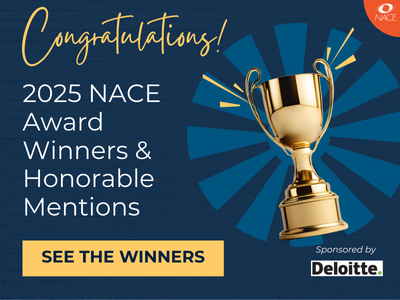What they are—and what do they mean for career services?
NACE Journal / Summer 2024
On July 1, as part of its regulations around financial aid, the U.S. Department of Education (DOE) released regulations that apply to all higher education Title IV participants—including a requirement that schools offer “adequate career services.”
Deputy Assistant Secretary Flores noted that colleges’ sharing previous student career outcome data in marketing materials or otherwise is not considered a “promise” of a career.
The regulations note that the definition of “adequate career services” will be determined by the DOE based on:
- The share of students enrolled in programs designed to prepare students for gainful employment in a recognized occupation;
- The number and distribution of career services staff;
- Whether the institution has promised access to career services to prospective and current students; and
- Whether the institution has partnerships with recruiters and employers that regularly hire its graduates.
In addition, the regulations require institutions to provide students with accessible clinical or externship opportunities related to and required for completion of the credential or licensure in a recognized occupation within 45 days of the successful completion of other required coursework. These opportunities must be geographically accessible, based on factors such as urban versus rural commuting zones, the degree level, and whether a program is highly specialized.
Key Concerns
On July 10, Antoinette Flores, deputy assistant secretary for policy, planning, and innovation at the DOE, offered NACE members context for and guidance about the regulations through a NACE-sponsored webinar. She also answered member questions and provided written responses. The following represents her responses to key concerns members had based on our webinar and her written responses.
Concern: How will metrics determining “adequate career services” be benchmarked and measured?
Deputy Assistant Secretary Flores said that the DOE does not have a specific formula to determine the underlying factors identified
in the “adequate career services” requirement. She noted that such an approach would not properly capture the significant variation that exists among institutions. For instance, an institution that only offers career-oriented programs
might need different staffing than one where only one program is career-oriented and the vast majority of students are being prepared to transfer to higher-level programs.
The new regulations highlight the importance of career services—particularly those that are well-funded, staffed, and supported.
Further, she shared that the DOE thinks that the language provides flexibility to consider the range of institutional circumstances when considering whether there are sufficient career services. The DOE believes that institutions should have sufficient career services to help students find jobs and honor any commitments made about the type of job assistance they provide. The DOE’s focus on evaluating institutions will remain on whether the institution can make good on its commitments with appropriate staff and resources in place while institutions are best equipped to determine what is appropriate to offer based on the education it provides. Institutions will be aware of what they have available for students, and they should provide accurate information about what services they offer.
She noted that the DOE determines the adequacy of career services staff based on varying factors. The DOE will consider the factors set out in the regulations in relation to characteristics of the particular institution, such as its size, the number and types of programs offered, and the requirements for employment in those fields of study. A finding of a lack of administrative capability under this provision would not be automatic. Therefore, institutions that rely on career services support across the faculty could present this information to the DOE if they are identified for administrative capability concerns; in such an instance, the DOE could take faculty support into consideration.
Concern: The regulations also require that institutions provide students with accessible clinical or externship opportunities related to and required for completion of the credential or licensure in a recognized occupation within 45 days of the successful completion of other required coursework.
Flores stated that does not mean the experiences must start exactly within 45 days. However, the DOE will consider whether there is a pattern where these experiences start well outside reasonable periods. For example, offering an opportunity
that starts a year after the student has successfully completed the required coursework is a sign that an institution is not abiding by the requirement and does not have sufficient spots for clinical experiences or externships; such a situation would
result in a finding of a lack of administrative capability.
NACE members: Access the recording of "Financial Aid’s New Career Services Regulations"
The DOE did not provide a specific set of metrics for measuring what is geographically accessible, as there could be programs on the edge of one commuting zone or another, and different program types could have different expectations for what is geographically accessible. For example, Flores noted that a clinical experience tied to a highly specialized field as part of a graduate program may see a geographically accessible option as one that is in another part of the country. By contrast, a commuting zone concept is likely to be a better fit for certificate programs where students are more likely to be staying close to where they live. The DOE believes it is critical to maintain the requirement about geographic accessibility for clinical experiences and externships to prevent institutions from circumventing the intent of the requirement by simply offering students an opportunity that is not feasible for them to reach.
In terms of assessing geographic accessibility, Flores noted that the DOE would consider how accessible distances look very different in rural areas versus urban ones. The level of the credential will also likely affect this consideration. Someone completing a professional degree in a highly specialized field is almost certainly going to have travel longer distances for a clinical experience; consequently, this would be viewed as accessible and in line with DOE expectations. By contrast, a student completing a 12-month certificate program is not likely expecting to move hundreds of miles away for a clinical experience. Nor would such a student be completing a credential with a level of specialization such that there may only be a handful of relevant placement options in the country. Preserving the concept of geographic accessibility while recognizing the need for flexibility in how that is considered based upon the credential level, type, and the physical location of the institution is appropriate.
Concern: Are there reporting requirements associated with the regulations?
Flores noted that there is nothing that colleges need to report to the DOE, and there are no plans for proactive audits. Instead, what would trigger an investigation
is a student complaint to the DOE that promises were made in regard to career outcomes that did not come to fruition.
She also noted that colleges’ sharing previous student career outcome data in marketing materials or otherwise is not considered a “promise” of a career.
Implications and Recommendations for Career Services
What does this mean for career services in higher education?
While new regulations may cause unease, they can also provide an opportunity for career centers to seize the moment.
The regulations highlight the importance of career services—and particularly well-funded, staffed, and supported career services. This is a critical time to think about what it would take for a student to have the “adequate” and necessary support for coordinated career exploration, development, and preparation that is clearly communicated and builds from orientation through graduation both within and beyond the classroom.
Career services professionals should use this moment to elevate their critical work on campus. It is important for career services to share the regulations with top university leadership; these regulations highlight how important it is for leadership to be committed to career services.
How can career services professionals do this?
Advocate for the strategic positioning of career services. Career services should be strategically positioned to provide the vision, guidance, and relationships to demonstrate its importance and value and to maximize student outcomes. The DOE’s new regulations can serve as an important rationale to begin and/or accelerate conversations. This will help to ensure compliance with the regulations.
Leverage benchmarks to ensure adequate resources. NACE’s Career Services Benchmark Report is an effective tool to gauge where your institution is compared to comparable ones in regard to career center staff, budgets, and resources. You can then use these data to advocate for your office.
Advocate for support in collecting outcome data of students. Outcome data for college graduates is critically important but is labor intensive to collect. The regulations highlight the importance of career outcomes; ensuring career services staff are able to collect outcomes requires staffing, time, and resources. In addition, NACE’s First-Destination Survey provides the opportunity to benchmark your institution’s outcomes to those of comparable institutions.
Integrate career readiness competencies throughout the institution. Work with your administrators and faculty to implement the competencies throughout the institution to align outcomes with career readiness. Competency learning, development, and articulation should be made apparent and infused into the curriculum and co-curriculum throughout the student experience to provide opportunities for students to actively demonstrate and articulate competency development and readiness. Framing programs, services, and one-on-one conversations around competencies provides students with multiple touchpoints throughout their time at the institution to practice telling their story and representing their learning in a way that will land them their first internship and their first job.
Engage with faculty to implement career into the classroom. Develop a mechanism for sustained faculty professional development focused on NACE competency integration. This must include, as the most basic level, explicit alignment with NACE career readiness competencies in the curriculum. Ideally, faculty would also find ways for students to practice representing their competency development after major assignments or projects in a way that would mimic the interview process and help them select major learning experiences to add to their resume. There would also be support for faculty to engage in meaningful ways with local, discipline-relevant employers to ensure course and program curriculum remains up to date. This might include things like project creation, guest lectures, or industry visits.
Use the NACE Competency Assessment Tool to demonstrate competency development of your students through classes, work-based learning opportunities, and other opportunities. Competency development and career readiness should be integrated broadly into the life and culture of the institution, and their value should be reflected in institution/division/department strategic plan and integrated assessment processes. In fact, there is an opportunity with the recent release of the NACE Competency Assessment Tool to integrate competency assessment with other assessment underway. Cultivating and sustaining relationships with upper administration, faculty, staff, students, and employers is essential for making a competency initiative part of the fabric and vocabulary of the institution.





